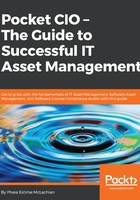
Preface
Anyone at the executive level deals with a plethora of questions and concerns that would make any normal person's head swim. However, those at the C-level cannot afford that, and so they seek answers as a means of ensuring that all is well within the organization. This tactic works until they look at IT. Getting a good, solid answer to the question, "Are we getting a good return on our investment in IT?" is never easy, direct, or straightforward even for many IT managers. Trust us: this situation is commonplace in every industry. Given that a company's IT spend is, next to salary and benefits, the biggest item in the budget, it's almost mindboggling that accountability in this mission critical is so hard to come by. Executives care about the value IT components represent. They long to understand in a concrete manner how IT provides value through cost reductions, new revenue streams, growth opportunities, and compliance.
The credibility of your IT department is at stake if your CIO cannot answer the following seven essential questions:
- What assets are in place?
- What return are our assets providing to the business?
- How are you improving our assets' return?
- How are our asset investments performing?
- How are our asset investments performing relative to our competition?
- Do our assets put our business at risk in any way? Software? Cyber?
- If so, how are we managing that risk?
In most modern organizations, responsibility for providing these crucial answers falls to the CIO. Still, although ownership of this task is clearly defined, questions still abound:
- How can the performance of IT assets be quantified?
- How can CIOs demonstrate the effective management of IT assets?
- How do CIOs demonstrate that IT provides a solid ROI?
- How do CIOs convey the message that this return is greater than what competitors generate?
The good news is this: there is a way to get the rock-solid answers and evidence every organization must have. ITAM is that way! In this book, I will illustrate exactly how ITAM enables the CIO and their team to answer these important questions. ITAM, which comprises processes, tools, data, and people, manages the entire life cycle of an IT asset (hardware and software). ITAM and SAM best practices allow executives to operate in a predictive manner in terms of what assets the enterprise expects to acquire, as well as what assets it must release.
ITAM not only tracks the costs of every IT asset; it also maps IT assets to business services in a truly meaningful manner. ITAM conveys asset cost information essential to determining the return generated by any given business service. ITAM and SAM help increase those returns through effective vendor and contract management. Lastly, risks associated with IT assets are managed effectively because ITAM and SAM provide insight into vendor warranties and support commitments, software vulnerabilities, entitlements, and asset disposal.